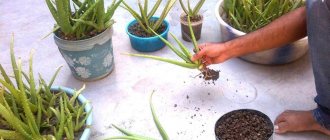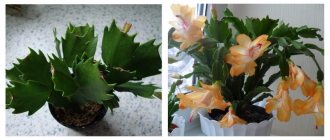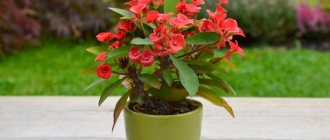Where to put aloe
To prevent the plant from having a pale color, stretching out and taking on an ugly shape, you should avoid the north side of the apartment. The best option is considered to be the southern, south-eastern and south-western sunny sides, where there is more light. Here aloe will feel good and will not lose its decorative effect.
You cannot change the conditions of detention suddenly. If the plant grew in the shade, then it should gradually adapt to the light. Otherwise, stress may cause the leaves to turn yellow. Therefore, place the aloe in bright light for half an hour to an hour, gradually increasing the duration.
During warm summer and spring periods, balconies and loggias are a good option. It is dangerous if the plant is in the open air and is flooded with frequent rains. Due to waterlogging, the roots may rot and the plant will die.
Winter for most succulents including aloe is a period of hibernation. A cool room with a temperature of 13-15 °C is recommended. But in the absence of this, ordinary room temperature will do. When the lighting level in the room is low, use additional light from a lamp.
Avoid rooms with drafts.
If you believe the signs, then aloe is a symbol of love, which means it is well suited for the bedroom.
Selecting a pot
The first thing you should pay attention to is the material from which the pot is made.
Most often it is plastic or clay. The first is cheap and lightweight, but its inability to allow air to pass through can be detrimental to the root system. So the pot must be clay. The shape does not matter, and the size and diameter must be selected depending on the volume of the roots and the height of the plant. For example, caring for indoor aloe spinosa requires a shallow bowl of large diameter, since this succulent (the so-called plants that have special tissues for storing water) has a shallow root system, and tall aloe vera (the plant reaches a meter in height) needs a deep pot.
Proper care of aloe requires the presence in the container of one or more holes with a diameter of 1-1.5 cm, through which excess moisture will escape. Before planting, old pots must be thoroughly washed with soap, and clay pots should also be calcined in the oven to kill harmful microorganisms.
Possible problems during landing and immediately after it
The most unexpected surprise when planting aloe is rotten roots. Even if at least a few healthy roots remain, the plant can be successfully revived. To do this, remove all damaged areas of the root system and immerse the remaining roots in a solution of an antifungal or antibacterial drug, depending on the causative agent of decay.
After this, the plant is left to dry for at least 4–5 hours, then planted in the substrate, but not watered. The succulent is observed for 10–14 days. If putrefactive processes have not resumed, moisturize very sparingly and rarely until the flower is completely restored.
Another, no less common “surprise” during planting is the egg-laying of mealybugs between the roots. The plant is washed well in a soapy solution, turned upside down so that all the liquid drains and does not remain in the axils of the leaves. The pot and substrate are changed, the old ones are thrown away. The succulent is treated with an insecticide and planted in a new flower container. Watch to see if the scale insects have appeared again. Usually one treatment, even the most thorough one, is not enough, and aloe is treated again with another preparation.
Requirements for substrate and feeding
Another feature of aloe care is the choice of soil. The plant is suitable for nutritious and loose soil that allows air and moisture to pass through well. You can buy special soil for succulents at a flower shop, or you can prepare it yourself. To do this, you will need 2 parts of turf with the addition of clay, 1 part of leaf soil and 1 part of coarse sand. To increase looseness, you can use broken bricks, shells or perlite. When planting at home, a layer of drainage 3-4 cm thick should be poured onto the bottom of the pot. From March to September, you need to take care of aloe at home especially carefully: at this time the flower is actively growing, so it requires nutrients and minerals. It is necessary to regularly feed the plant with complex mixtures containing phosphorus and potassium. There is no need to fertilize it in winter. Fertilizing is applied 2 times a month in accordance with the recommendations indicated on the package. In this case, you need to follow a number of rules:
- you cannot fertilize the succulent immediately after transplantation, since during this period it is especially vulnerable;
- before applying fertilizing, the plant must be watered;
- it is not recommended to feed a flower planted in a special substrate for 10 months, because too much concentration of nutrients can harm it;
- It is best to pour the fertilizer into a tray or into moist soil, avoiding it getting on the leaves and stems.
How to replant Aloe
Aloe has a developed root system, so it needs regular replanting into larger pots. Young plants are replanted annually in early spring. Adult flowers - once every two to three years. The new pot should exceed the previous one in volume by 1/5. Before transplanting using the transshipment method, the plant is not watered for three days. When choosing a new pot, you need to focus on the location of the roots. If the roots have grown deep, then a higher pot is selected. If the roots grow wide, then select a pot with a larger diameter.
A layer of expanded clay drainage must be poured onto the bottom of the pot. The soil should be light, without peat. You can buy a ready-made soil mixture for succulents. If it is not possible to buy a ready-made substrate, then you need to take the following components:
- leaf soil;
- turf land;
- sand.
This may be interesting: Prickly pear - growing at home
These ingredients are taken in a 1:2:1 ratio. To add looseness, it is recommended to add fine expanded clay, vermiculite or charcoal.
How to replant a plant
Transplanting aloe is an important undertaking. The fact is that over time, there are less and less nutrients in the substrate, the soil is depleted, becomes light like dust, and after watering it crusts over. In this case, it is useless to feed the succulent, since fertilizers will not fail to replenish the humic component of the soil. The problem can only be solved by completely replacing the substrate. A young flower should be replanted once a year, after the plant reaches 3 years - less often, once every 3-4 years. The transplant includes 6 stages:
- Aloe must first be watered abundantly: this will allow the roots to be removed along with the soil without injuring them.
- Let's prepare the pot. It should be 1/4 larger than the previous one. Drainage is poured onto the bottom of the dish, then soil is poured up to half of it.
- The container with the plant is placed on its side, the aloe is carefully removed from it, and the root is freed from clods of earth. It is important to prevent damage - let some of the old substrate remain on the roots.
- The succulent is placed in a new pot, its roots are straightened. In this case, they should be at a distance of 3-3.5 cm from the walls, but not touch them.
- The roots are covered with soil from above so that the root collar is buried to the same level as before. The soil should be compacted a little.
- The transplanted plant is watered and placed in a shaded place for several days. There is no need to moisten or spray it all this time.
Aloe care
At home, the plant is not picky and does not make any special demands on itself. The main thing is not to overfill it, but also not to overdry it, and adhere to a reasonable watering regime. In summer, aloe is usually watered once a week, in winter, when the succulent is at rest, once a month.
How to water a plant
Watering from above is used with caution, watering along the wall of the vessel, and not under the very root collar. You should be careful not to get water inside the rosette of leaves. If, due to carelessness, moisture still gets deep into the axils of the leaves, you need to thoroughly blot it with a dry cloth.
Watering from below into a tray is more suitable for the plant. The succulent itself will take as much water as it needs, but the rest must be drained. Stagnation of water in the pan is extremely harmful to the flower - it leads to rotting of the root system and death of the perennial.
Spraying for aloe is optional. It does not need high air humidity; the plant in its natural habitats - in South Africa and the Arabian Peninsula - is accustomed to the dry air of savannas and deserts. In too hot weather, it is advisable to place a vessel with water next to the plant. By evaporating, it will weaken the effect of heat on the flower.
Fertilizer for aloe
To replenish the supply of nutrients in the soil mixture, fertilizer is used for cacti and succulents. Feeding is carried out from mid-spring to the end of autumn several times during the growing season; aloe is not fed during dormancy.
Gardeners should be reminded that the plant is watered before fertilizing so that the root system does not suffer from excessive exposure to nutrients and does not get burned. It is better to fertilize aloe on a cloudy, cool day or when the sun is already setting.
Many succulent owners practice feeding with folk remedies - sugar solution, eggshells crushed into powder, water after washing cereals - rice, buckwheat and others, infusion of onion peels.
Is aloe pruning necessary?
This question interests more than one gardener, especially if the plant grows and ages. Many people are interested in when it is possible to prune aloe for medicinal purposes.
For preparing aloe juice, it is advisable to use leaves cut from specimens no younger than 3 years old, or even better from five-year-old flowers. To do this, cut off the lower leaves at the base with a sharp tool, put them in the refrigerator for a week to start the biostimulation process in them, only then prepare aloe juice from the leaves.
The leafy shoots of tree-like aloe look extremely unaesthetic, so they are cut off, the tops are rooted and new plants are obtained, and young shoots grow from the cut stumps, forming a neat, lively bush.
For many other types of succulents, sanitary pruning of aloe is necessary, when all old and damaged leaves are removed. It is best to produce it at the end of the dormant period. After the inflorescences wither, the flowering stems are also cut off at the very base.
Root shoots and stem cuttings should also be cut off in a timely manner so that they do not draw strength from the mother plant, and during replanting, the roots are pruned - those that died during the dormant period, damaged and rotted, if any, are removed.
Lighting, temperature
In nature, the succulent grows in areas with a warm and dry climate: in Africa, Madagascar, and the Arabian Peninsula. This must be taken into account when providing aloe care at home. It is better to grow a flower in the house at a temperature of 22 to 26°C; it can be safely placed on a windowsill on the south or east side.
The sun is the source of life for aloe, determining its growth rate and appearance. For example, the leaves of aloe spinosa, which grows in a well-lit place, have a bright dark green or even brown color. When placed in a dark corner, the plant turns light green and never blooms. At the same time, too much sun will also not do the succulent any good: exposure to direct rays can cause the plant to burn.
To keep the aloe trunk strong and the leaves large and bright, it is useful to take it out onto the balcony, but not forgetting to protect it from wind and rain.
Plant transplant method
After the preparatory work has been completed, you can begin the main work. Considering the age of the plant and its size, it is advisable for the owner to know how to replant aloe at home. The procedure should be something like this:
- Take a plant and examine the rhizome. If it grows to the sides, then you need to choose a wide pot. If the rhizome grows downwards, then a deep bowl will be required.
- Pour a little earthen cushion into the prepared pot.
- Carefully take the plant and place it in a new container, adding a little soil to the sides.
After a few days the soil may become compacted and may need to be added a little bit at a time. Place the transplanted plant in the shade for about a week. Watering begins after five days. Only after this time has passed, the plant is transferred to a lighted place.
Watering and spraying
When providing aloe care, it is important to organize proper watering. You need to water the plant as the soil dries out - 1-2 times a week. At the same time, excess moisture is detrimental to it. It is especially dangerous in the cold season: overwatering in combination with low temperatures leads to rotting of the roots and death of the flower.
For irrigation, it is better to use settled or boiled water, since tap water contains a lot of chlorine that is harmful to plants. The temperature depends on the season: in winter and autumn it should be 7°C above room temperature, in spring and summer the permissible range is from 20 to 33°C.
You can water a houseplant both from above and from below. When top watering, a watering can is used, the stream of water is directed under the root. Under no circumstances should it be allowed to come into contact with an outlet. At the bottom, the liquid is poured into the pan, and the plant itself takes as much moisture as it needs. This type of watering is considered more preferable. To stimulate rapid growth, it is recommended to add a little concentrated juice of the succulent itself to the water.
The flower does not need to be sprayed frequently, and some species, such as aloe vera, do not need this at all at home.
Indoor aloe
You can grow aloe at home as an ornamental plant or just to decorate a room. For example:
- Aloe variegated (striped, tiger). Externally, the plant is very similar to a small tree.
- Aloe marlote. It is a succulent with large and wide leaves. There are red thorns on the leaves.
- Aloe squat. A small plant, perennial, the leaves are grey-green or grey-blue with many spines.
- Aloe whiteflower. A rare flowering plant without a stem, the flowers resemble lilies.
Indoor succulents do not produce seeds, their peduncles are much shorter, and their flowers are smaller. When the plant fades, the arrow must be removed. Growing aloe at home (both decorative and medicinal) is not difficult.
Seasonal conditions for growing plants
Many novice flower growers do not know how to care for aloe at home in winter, and continue to carry out the same activities as in summer, but this is wrong. In the spring and summer, the agave actively grows and new leaves appear. In variegated and tree-like aloe, they grow from 5 to 7 per year, in squat aloe - from 6 to 10. At this time, it is important to fertilize the flower regularly and provide it with enough water and light.
In winter, aloe goes dormant and its growth slows down. During this period, you need to water the plant no more than once every 25-30 days. If it grows on a windowsill, then additional lighting is not needed; if in a shaded place, it is better to turn on a phytolamp for it. If possible, the flower should be placed on a heated veranda or balcony, where the air temperature does not exceed 13°C; in such an environment he will feel comfortable. The minimum temperature that aloe can tolerate is 10°C.
Kinds
Several types of aloe are grown at home.
Aloe arborescens
The most popular type is tree aloe or agave . It is distinguished by an erect stem with long narrow leaves decorated with sharp teeth. At home it can reach a height of one meter. It should be noted that in apartment conditions, agave practically does not bloom, and if you manage to see this rare phenomenon, then its flowers grow small. Due to its medicinal properties it is very popular.
Aloe vera
Aloe vera is distinguished by the absence of a long stem; the fleshy leaves form a dense rosette. The leaves are smoky green with serrated edges and grow up to fifty centimeters. In recent years, aloe vera has become popular due to its use in the cosmetics industry. Under natural conditions, aloe vera grows in the Canary Islands, reaching a height of 80 centimeters.
Aloe Variegata
Aloe Variegata (Variegata) is less common among indoor floriculture enthusiasts. Bright green leaves with white stripes, collected in a rosette, look beautiful. The height of the plant does not exceed forty centimeters.
This may be interesting: Decembrist (Schlumberger) - description, types and varieties
Aloe pruning
What can be trimmed from aloe:
- yellowed, wilted, ugly and diseased leaves;
- the best healthy juicy leaves for further use of healing properties in folk medicine;
- roots;
- tops;
- shoots at the base of the roots (babies);
- cuttings.
Sanitary pruning
Sanitary pruning is needed to rid aloe of shoots and leaves with spots, infections, and signs of disease.
The procedure is quite simple.
Disinfect the knife or pruning shears (for tough old plants). You can disinfect an instrument either by heating it or using the following liquid agents:
- potassium permanganate solution;
- household chlorine bleaches;
- - alcohol or vodka;
- - kerosene.
Carefully inspect the plant and look for any defective leaves. Cut them carefully so as not to damage the stem and other leaves.
If the plant has grown greatly, then form the desired shape by removing unnecessary leaves and cuttings.
Pruning for propagation
The easiest way to propagate aloe is by children. To do this, it is easier to completely remove the aloe from the pot and separate the shoots at the base of the roots from the mother plant, using a sharp knife if necessary.
The process is similar when picking seedlings; small plants are separated from each other by hand if there was dense sowing.
Another good way to propagate aloe is by cuttings - shoots on the stem. They are torn off from an adult plant by hand or by a careful cut at the base.
Trimming for medicine
By the age of three, the chemical composition of aloe is maximally rich in healing substances and the plant is suitable for preparing medicines. For pruning, the lower large, smooth leaves without damage, spots or diseases are selected. Carefully cut off with a disinfected knife at the base. The main thing is not to damage the crown and stem of the aloe.
The leaves should be kept in the refrigerator for 10 days to initiate the processes necessary to obtain the medicine. More detailed information on the preparation and use of healing compounds is here.
Aloe root pruning
The roots are cut off when replanting the plant, if there is such a need, or to rid the aloe of fungal and bacterial infections and rot. To do this, the aloe is completely removed from the pot. Hold the plant at the base with one hand, and turn the pot over with the other. You may need the help of another person if the pot is large.
The soil is completely separated from the roots. Excess, dried, rotten, diseased roots are trimmed with a knife or scissors. Inspect carefully; if there are infections, treat the pot with chlorine solution (bleach) and the roots with charcoal powder.
If there are no diseases, and excess and too long roots are cut off, then no additional treatment is required.
After replanting the plant, you should not water it for 2-3 days so that the cuts heal.
How to make agave bloom at home
It is generally accepted that aloe blooms only once every hundred years, which is why it is popularly called the agave. But this is nothing more than a myth. Flowering can be achieved even in an apartment; the main thing is to properly organize the care of the plant at home, creating an environment for it that is close to natural.
During the first 3 years, you should not wait for aloe to bloom. After reaching three years of age, the succulent needs to be replanted in the spring, and in the fall, when it stops growing green mass, begin preparing for wintering: provide lighting for 12-15 hours and dry air with a temperature of up to 13°C. If all necessary conditions are met, aloe will bloom in winter. During this period, the plant shoots an arrow 40-50 cm long, at the end of which a panicle is formed from many future buds, yellow, orange or red - depending on the species. Their shape resembles elongated bells. Gradually, the buds open, but not all at once, but one by one, from bottom to top, and when the top ones bloom, the bottom ones are already fading. At this time, the pot with the succulent cannot be moved or moved to another place. The plant blooms for 6 months. After this, you need to carefully trim the stem so that it does not deplete the aloe.
How to propagate Aloe
Aloe is easy to propagate due to its ability to quickly take root and its unpretentiousness. Under natural conditions, reproduction occurs by seeds and shoots growing from the roots. It is unlikely that you will be able to obtain seeds at home, but if you wish, you can buy aloe seeds in specialized stores.
Aloe from seeds
Growing agave from seeds is the most time-consuming and labor-intensive method. It is recommended to sow seeds in late winter - early spring. Prepare an earthen mixture of sand, leaf and turf soil in a ratio of 2:2:1. Place the seeds in a container with moistened soil, lightly sprinkling them with soil. Cover the top with transparent film or glass. The seedlings are placed in a bright place with an air temperature of about 21 degrees. The soil must be periodically moistened with a spray bottle so as not to damage the sprouts, and ventilated. Seedlings with four leaves must be plucked and transplanted into the same substrate. The grown sprouts are transplanted into separate pots. After a year, they are transferred to containers with a larger diameter and cared for as adult plants. This propagation method is suitable for experienced gardeners and those who like to experiment.
At home, it is easier and simpler to propagate agave using the following traditional methods:
- shoots;
- cuttings;
- apex;
- leaf.
Aloe shoots
The shoots (babies) grow right at the root and have their own root system. It is necessary to carefully separate them with a sharp knife and air dry them until the cut is dry. Then the cut is sprinkled with crushed activated carbon. For planting during propagation, it is recommended to use a soil mixture made up of sand and leaf soil in equal proportions. You can add some turf soil. Some gardeners use clean sand for germination. The shoots are planted in moist soil, covered with a jar or plastic bag until rooting.
Alohe cuttings
Cuttings grow from the main trunk, between the leaf and the trunk. Aloe can be propagated by cuttings at any time of the year. They are cut or broken off near the trunk itself, then left to dry in a dark place for five days. The cut area is sprinkled with fine charcoal or activated carbon. After the cut has dried, the cuttings are planted in sand or an earthen mixture prepared according to the proportions indicated above. The roots will sprout in about a week, and the new plants can be potted into the succulent potting mix.
Rooting the top of the aloe
To propagate aloe, the top is cut off so that 6-7 leaves remain on the cutting. The leaves from below are removed. The top is placed in a jar or glass of water so that the water covers the lower part without leaves. After the roots have formed, the sprout is transplanted into a pot with an earthen mixture.
Leaf propagation
Agave can be propagated by leaves at any time of the year. The leaf from the bottom of the plant is cut off at the base of the trunk. The leaf is placed in a dark place to allow the cut to dry. Then the cut is sprinkled with crushed activated carbon, which disinfects and prevents the development of putrefactive bacteria. The leaf is deepened three centimeters into the soil mixture for germination, the recipe for which is given above. The soil should be kept moist; it is recommended to cover the container with a transparent bag.
This may be interesting: Sedum (Sedum) - home care











